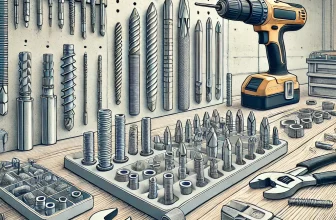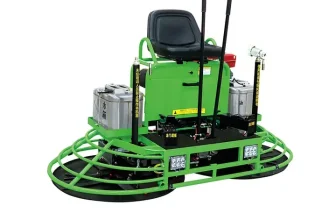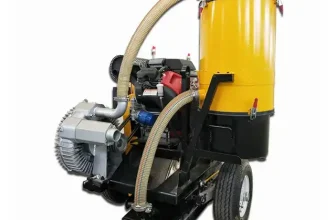A concrete agitator is a specialized machine used in the construction industry. It is designed to mix cement, aggregates like sand or gravel, and water to form concrete. The term ‘Agitator’ correlates with the device’s main function – agitating or keeping the mixed concrete in motion to prevent it from hardening or separating. It essentially works as a portable concrete mixing factory, delivering fresh concrete ready for immediate use at construction sites. In the broad construction industry landscape, the concrete agitator has gained significant importance due to its essential role in maintaining the integrity and quality of the concrete until the point of use.
Importance of Concrete Agitator
The importance of a concrete agitator cannot be understated in construction and infrastructure projects. Its chief role is to ensure that the components of concrete, such as cement, sand, and water, are thoroughly mixed to create a uniform mixture. This is essential to achieve the desired strength and consistency in the final concrete product. Whether it’s building a skyscraper or paving a road, a concrete agitator forms a crucial part of the process. It not only provides a consistent quality but also enhances work efficiency by saving time and effort. Without this valuable equipment, mixing concrete on a large scale would be time-consuming, labor-intensive, and prone to errors, which could lead to weak structures and potential failures. Thus, it is clear that concrete agitators play an instrumental role in numerous construction and public works endeavors.
How a Concrete Agitator Works
Various Parts of a Concrete Agitator
A concrete agitator is a complex piece of equipment made up of several critical parts, each serving a specific function in the mixing process. First, there is the mixing drum – a large cylindrical component which is the main space where the concrete ingredients are combined together. The drum rotates around a horizontal axis, facilitating the mix.
Another important part is the loading chute. This is where the ingredients; sand, gravel, water and cement are fed into the concrete mix. The chute can be directed to any angle, ensuring flexibility in feeding the materials.
Inside the rotating drum, spiral blades or fins are fixed. As the drum moves, these blades lift the concrete mix to a certain height and then let it fall back, creating a homogenous mix.
The driver’s cab is where the operator controls the rotation speed of the drum, the direction of rotation and other vital parameters of the utilisation process. In some cases, this can also be remotely controlled for worker safety purposes.
Lastly, there’s the engine – the power source for the concrete agitator. It’s usually a diesel engine that powers the turning drum and, in turn, the mixing process. Some newer models are being produced with electric engines for better energy efficiency and to reduce emissions.
Process of Mixing
The actual process of mixing in a concrete agitator is quite fascinating. It starts with the loading of dry materials – cement, sand, aggregates – into the drum. Along with this, the appropriate amount of water is also added. This is generally determined by the specific requirements of the concrete mix design.
Once all materials are loaded, the mixing process officially begins. The concrete agitator’s drum starts rotating, usually in one direction, to combine the components. The interior of the drum is fitted with blades that help in mixing the elements thoroughly. These blades lift and drop the materials continually, ensuring an even blend.
The mixing usually continues until a homogeneous mix is achieved. This is critical as it ensures that the final concrete produced will have consistent properties throughout. Generally, modern concrete agitators are equipped with timers or sensors to aid in determining when the mixing process should stop.
It’s also important to note that the drum must keep rotating even after the mixing is complete, especially if the concrete is not immediately discharged. This is to prevent the concrete from setting or segregating. This process, known as agitating, is where the concrete agitator gets its name.
Types of Concrete Agitators
Drum Mixer
The Drum Mixer is one of the most common types of concrete agitators used in the construction industry. Aptly named because of the drum-shaped mixing container, drum mixers work by rotating this drum to mix the concrete components. Contrary to popular belief, the drum doesn’t rotate to stir the elements within but to lift the material up to then let it fall back down due to gravity. This repetitive action allows for a consistent and thorough mixing of aggregates.
There are two primary types of drum mixers – the non-tilting drum mixer and the reversing drum mixer. The non-tilting drum mixer retains a steady drum posturing whereas the reversing drum mixer, as the name suggests, reverses its direction for mixing and discharging the concrete. Both these variants have unique advantages in terms of usage and operational efficiency.
Pan Mixer
The Pan Mixer is another popular type of concrete agitator. It is unique in its design, boasting a circular pan or basin where the concrete is poured into for agitation. The mixer uses one or two sets of blades or star-shaped stirrers that rotate around the vertical axis. The blades are fixed in such a way that when they rotate, not only do they mix the concrete but they also lift and drop it for better mixing. Most pan mixers also have scrapers attached to ensure that no material sticks to the sides and bottom of the pan.
Pan mixers are particularly effective for mixing concrete that contains coarse aggregates. They are widely used in precast and pre-stressed concrete producing factories because the rigorous mixing process ensures a higher quality final product. They are also used when colored concrete or additives are required, as the intense mixing action ensures an even distribution of color and materials.
Pan mixers come in various sizes, from small laboratory units to large batch mixers capable of handling up to six cubic meters of concrete in one session. The versatility in size makes pan mixers suitable for both small-scale and large-scale construction projects. Despite their effectiveness and versatility, pan mixers are generally not mobile and are usually found in fixed concrete mixing plants. The stationary nature, however, allows them to have increased capacity and efficiency.
Non-tilting Mixer
Non-tilting mixers are one of the most common types of concrete agitators, widely appreciated for their simple yet effective operation. As the name suggests, non-tilting mixers contain a rotating drum that mixes the ingredients but does not tilt.
Due to its fixed orientation, the drum relies purely on its vigorous and continuous internal agitation to mix the concrete ingredients. Pouring out the concrete for use is achieved by inserting a chute into the drum, allowing the concrete to flow out by gravity.
Non-tilting mixers are advantageous when dealing with large volumes of concrete, as they tend to have larger capacities than their tilting counterparts. However, as a limitation, the mixer needs to be completely emptied before a new batch of concrete can be mixed.
Optimized for robustness and durability, non-tilting mixers are a common sight in heavy-duty construction projects, demonstrating their capacity for high-scale, intensive operations. Despite its simplicity, the design and efficiency of non-tilting mixers make them an invaluable resource in the concrete production industry.
Uses and Applications of Concrete Agitator
Construction Industry
Concrete agitators play a pivotal role in the construction industry. Among the myriad applications, the most prominent one is in the process of constructing buildings. For producing high-quality buildings, evenly mixed concrete is essential, and this is where the concrete agitators shine.
They are highly used in large-scale projects such as skyscrapers and commercial buildings, where a massive amount of concrete needs to be consistently mixed and promptly delivered. It ensures that the structure being built has the strength it requires.
Apart from building constructions, they are also used extensively in the construction of foundations, pavement works, and bridges. The concrete agitator facilitates efficient and swift mixing, reducing the overall time taken for the project, contributing significantly to meeting strict construction deadlines.
Underground construction in the form of tunnels or subways also utilize concrete agitators. Because these projects often require concrete to be delivered at different steps and stages, a mobile concrete agitator becomes indispensable in this scenario.
Infrastructure Projects
Concrete agitators come into play in various capacities in infrastructure projects. They are primarily used in bridges, highways, tunnels, ports, airports, and other such projects where concrete mixtures need to be available on demand and in large volumes. The flexible nature of the agitator ensures that concrete can be mixed and transported to even hard-to-reach areas, retaining its integrity and composition throughout. It provides an ideal solution to avoid the concrete from hardening before application. The necessity for a constant supply of concrete makes these agitators indispensable in these large-scale projects. Urbanization and growth of cities have significantly increased the demand for concrete for infrastructure projects, turning concrete agitators into a key component of successful construction process in major developments.
Advantages of Using Concrete Agitators
Consistent Mix Quality
One of the standout benefits of utilizing concrete agitators in construction projects is the ability to maintain a consistent mix quality. This machinery ensures that all materials integrated into the mixture are evenly distributed and consistently combined. This is achieved by the constant revolving motion inside the cylindrical drum, which doesn’t let the concrete solidify or segregate into its individual components. The result is a uniform, homogenous mix in every batch, alleviating any concerns about varying concrete quality. This assurance of consistency is critical because if the concrete mix is not homogeneous, it could lead to weaknesses and faults in the structural integrity of a building or construction project.
Efficiency and Time Saving
Using concrete agitators on your construction projects offers significant efficiency and time-saving benefits. With the ability to transport huge quantities of premixed concrete from the production site to the construction site, these machines decimate the need for onsite mixing. This means time can be saved that would otherwise be spent in manual labor. On top of this, there are no delays associated with waiting for individual batches to mix as the machine continuously keeps the mix ready for use.
In addition, concrete agitators have the capability to maintain the freshness of the concrete during transit by continuously agitating the mix. This advantage eliminates the rush associated with concreting work and allows you the luxury of time for perfecting your construction.
The automated nature of these machines also means less manpower is required, further enhancing efficiency. This allows builders to reallocate labour resources to other critical areas of their projects.
Lastly, they reduce wastage that often comes with manual mixing. By ensuring that each batch of concrete is uniformly mixed, the work output is maximized, saving time and enhancing work productivity. Hence, concrete agitators clearly offer a superior option in terms of efficiency and time-saving on any construction project.
Safety Measures in Using a Concrete Agitator
Proper Training
Proper training is an essential safety measure when using a concrete agitator. Given the size, complexity, and potential hazard of these machines, workers need to be well-versed in their operation. Training should cover areas such as understanding how to start, stop, and maneuver the agitator, knowing the components and their specific functions, and being able to spot potential problems.
Training should also educate workers about the risks involved and consequences of mistakes, such as tipping the agitator over or incorrect mixing which can lead to poor-quality concrete. As such, training is not just a matter of safety, but also about ensuring the delivery of a quality product.
Moreover, workers should be trained on site-specific hazards, such as uneven ground that might tip the agitator, or overhead power lines that could be struck by the agitator chute. This training needs to be ongoing, with refresher courses provided periodically to keep workers up-to-date with the latest safety protocols. With the right training, the risk of accidents can be greatly reduced, thereby enhancing productivity and reinforcing a culture of safety in the workplace.
Maintenance and Checks before Use
Before operating a concrete agitator, it’s critical to perform routine maintenance inspections and pre-use checks. This can not only safeguard the operator’s safety but also extend the machine’s lifespan and ensure its optimal performance.
Firstly, regularly check for any signs of wear and tear or damage on the concrete agitator. All moving parts, such as the mixers and internal agitating blades, should rotate smoothly without any creaking or grinding noises.
Secondly, it’s vital to verify that tires or tracks are in good condition and correctly inflated because a flat or damaged tire can lead to instability, especially when navigating uneven terrain.
A crucial part of pre-use check includes inspecting the engine, hydraulic system, and other power sources. Make sure the engine starts easily and runs smoothly. Check for any leaks in the hydraulic lines, as a leak could indicate a potential failure point.
Moreover, verify the cleanliness of the mixing drum. Leftover concrete inside can harden and potentially interfere with the machine’s mixing capabilities. Regular cleaning ensures the machine delivers consistent results.
Lastly, the water system needs to be examined which includes hoses, pipelines, and tanks. Maintain a proper water-cement ratio so that the produced concrete maintains good workability and achieves the required strength.
Remember, these checks should be conducted with the machine powered off to prevent accidents.
Proper maintenance and safety checks aren’t just responsible practice – they’re a necessity when operating heavy machinery like a concrete agitator. Regular preventative maintenance can help avoid costly repairs down the line and ensure the machine works safely and efficiently.
Conclusion
Summary of Concrete Agitator
A concrete agitator is a highly specialized and technical piece of machinery used widely within the construction industry. Its primary function is to prepare a homogenous mix of concrete, ensuring optimum quality and consistency. This is achieved through the action of various components such as the drum or pan for mixing, the non-tilting mixer for holding the mixture, among others.
There are various types of concrete agitators, each suited for different tasks and environments, from large infrastructure projects to smaller construction sites. Harnessing the power of concrete agitators not only enables consistent mix quality but also greatly benefits efficiency and time-saving aspects of construction projects.
However, as with any machinery, proper safety training and regular maintenance are crucial to ensure the safe and effective use of a concrete agitator. In essence, the concrete agitator’s impact on the construction industry is palpable, marking it as an indispensable tool that considerably enhances the sector’s productivity and quality.
Impact on Construction Industry
The influence of concrete agitators in the construction industry cannot be understated. They have brought about remarkable efficiency and consistency in concrete production, a key element in construction projects. The agitators have not only reduced the time taken to prepare concrete mixtures but also ensured a uniform mix, leading to stronger and more durable structures.
Moreover, the different types of concrete agitators cater to varied construction needs, further enhancing their usefulness in the industry. Whether it’s a small construction project or a massive infrastructure work, these machines play a pivotal role.
However, while their importance is unquestionable, safety should never be compromised. Regular maintenance checks and adequate training for the operators are essential to avert accidents and ensure the longevity of these machines.
With continuous advancements in technology, one can only look forward to more dynamic and efficient concrete agitators that will keep transforming the construction industry.







